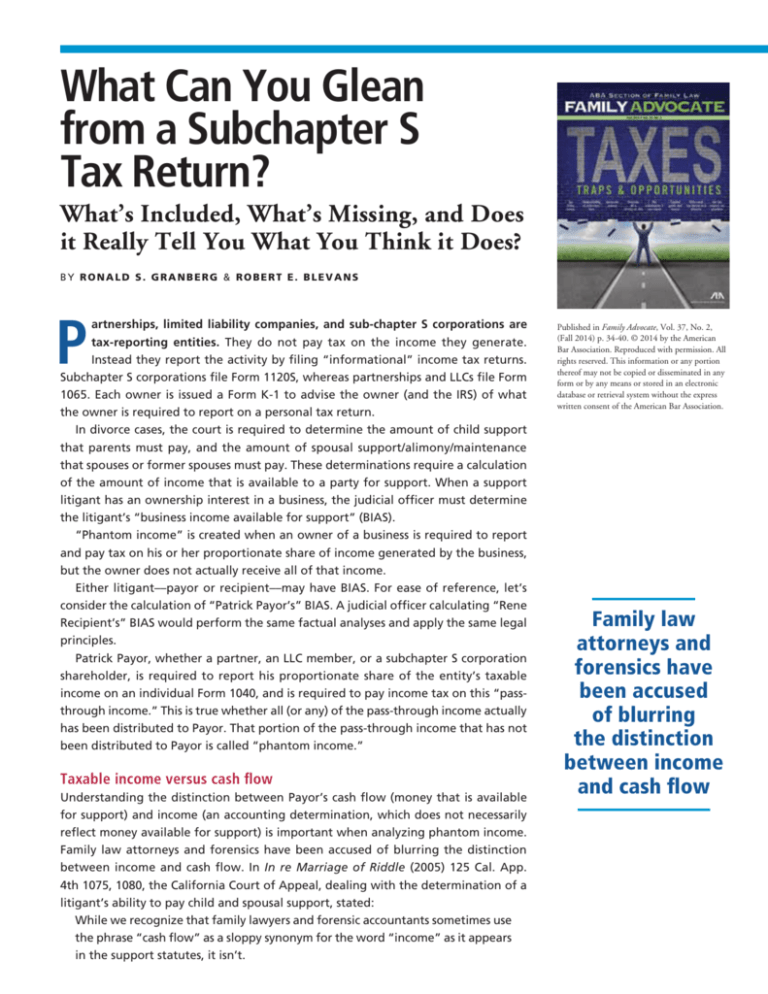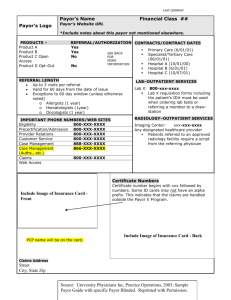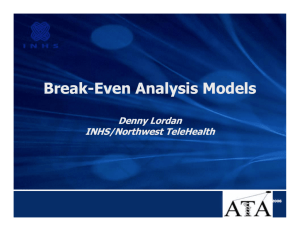
What Can You Glean
from a Subchapter S
Tax Return?
What’s Included, What’s Missing, and Does
it Really Tell You What You Think it Does?
B y R o n a l d S . G r a n b e rg & R o b e r t E . B l e v a n s
P
artnerships, limited liability companies, and sub-chapter S corporations are
tax-reporting entities. They do not pay tax on the income they generate.
Instead they report the activity by filing “informational” income tax returns.
Subchapter S corporations file Form 1120S, whereas partnerships and LLCs file Form
1065. Each owner is issued a Form K-1 to advise the owner (and the IRS) of what
the owner is required to report on a personal tax return.
In divorce cases, the court is required to determine the amount of child support
that parents must pay, and the amount of spousal support/alimony/maintenance
that spouses or former spouses must pay. These determinations require a calculation
of the amount of income that is available to a party for support. When a support
litigant has an ownership interest in a business, the judicial officer must determine
the litigant’s “business income available for support” (BIAS).
“Phantom income” is created when an owner of a business is required to report
and pay tax on his or her proportionate share of income generated by the business,
but the owner does not actually receive all of that income.
Either litigant––payor or recipient––may have BIAS. For ease of reference, let’s
consider the calculation of “Patrick Payor’s” BIAS. A judicial officer calculating “Rene
Recipient’s” BIAS would perform the same factual analyses and apply the same legal
principles.
Patrick Payor, whether a partner, an LLC member, or a subchapter S corporation
shareholder, is required to report his proportionate share of the entity’s taxable
income on an individual Form 1040, and is required to pay income tax on this “passthrough income.” This is true whether all (or any) of the pass-through income actually
has been distributed to Payor. That portion of the pass-through income that has not
been distributed to Payor is called “phantom income.”
Taxable income versus cash flow
Understanding the distinction between Payor’s cash flow (money that is available
for support) and income (an accounting determination, which does not necessarily
reflect money available for support) is important when analyzing phantom income.
Family law attorneys and forensics have been accused of blurring the distinction
between income and cash flow. In In re Marriage of Riddle (2005) 125 Cal. App.
4th 1075, 1080, the California Court of Appeal, dealing with the determination of a
litigant’s ability to pay child and spousal support, stated:
While we recognize that family lawyers and forensic accountants sometimes use
the phrase “cash flow” as a sloppy synonym for the word “income” as it appears
in the support statutes, it isn’t.
Published in Family Advocate, Vol. 37, No. 2,
(Fall 2014) p. 34-40. © 2014 by the American
Bar Association. Reproduced with permission. All
rights reserved. This information or any portion
thereof may not be copied or disseminated in any
form or by any means or stored in an electronic
database or retrieval system without the express
written consent of the American Bar Association.
Family law
attorneys and
forensics have
been accused
of blurring
the distinction
between income
and cash flow
Pass-through income can cause Payor’s cash flow and taxable income to differ
drastically. Payor’s pass-through income (i.e., pro rata share of pass-through entity
profit) comes within the definition of “gross income” under Internal Revenue Code
(I.R.C.) section 61.
The I.R.C.s definition of gross income does not address the issue of whether sums
Payor is required to recognize as income for tax purposes represent funds that are
actually available to Payor for the payment of child or spousal support. The fact
that monies are available for support doesn’t necessarily mean they are taxable as
income, and the fact that monies are taxable as income doesn’t necessarily mean
they are available for support. Differences between tax law and support law may be
illustrated by two examples: municipal bond interest and phantom income.
Municipal bond interest is not taxable to Payor, but is available to satisfy Payor’s
support obligation. The $10,000 in municipal bond interest that Payor receives during
a given tax year will be available for support payment purposes despite the fact that
it is not subject to income taxation.
Phantom income is taxable to Payor but unavailable to pay Payor’s support
obligation. If during a given tax year, Payor is required to report $10,000 in passthrough income, but receives no distributions from the business, his tax return will
show $10,000 in income, but none of it will be available to pay support.
When income generated by a business is not fully distributed to the owner, a careful
analysis must be done to determine why. If the Payor has manipulated distributions
by the pass-through entity to artificially reduce his BIAS, it may be appropriate for
the court to consider the phantom income as available when determining Payor’s
ability to pay support. As explained above, BIAS law must distinguish fraudulent
nondistribution of profit from bona fide nondistribution of profit.
Some states begin with a presumption that support income is different from
taxable income. Other states begin with a presumption that support income is the
same as taxable income. As a prerequisite to understanding phantom income, the
family law attorney should appreciate the differences between taxable income and
cash flow.
Others determine profit distribution
What happens to phantom income as BIAS to Payor when the decision not to
distribute profit was made by someone other than Payor? Consider the Maryland case
of Walker v. Grow, 907 A.2d 255 (2006), in which the husband was the chief operating
officer of a subchapter S corporation in which he held a 30% ownership interest.
The issue on appeal was whether corporate phantom income should be included
when calculating the husband’s appropriate level of child support. The court noted
that the husband did not receive the phantom income because, first and foremost,
he was a minority shareholder and had no right to force the corporation to make
distributions. However, Walker v. Grow places on Payor the burden of proving that
he hasn’t manipulated business distributions in order to avoid his support obligation.
If Payor carries that burden, his phantom income will not be included as BIAS.
It is common for a pass-through entity to make a distribution to Payor only
sufficient to pay the income tax liability on Payor’s pass-through income. A serious
complication is created when there is pass-through income to be reported, but there
are no distributions to the owner, or distributions are less than the tax on the passthrough income. Not only is the pass-through income not available for the payment
of support, but also the taxes that have to be paid actually reduce cash that would
have been available from other income sources.
Payor bears
the burden of
proving that the
nondistribution
of phantom
income was
bona fide
Pass-through income
Consider the situation in which Payor is a medical doctor who is also a member of
a partnership that owns the building where his practice is located. Assume that he
has net after-tax earnings from his medical practice of $240,000 per year. Ignoring
Payor’s ownership of the partnership interest, he would have net-after-tax income for
support of $20,000 per month. However, as a partner, he must report and pay taxes
on $100,000 in annual pass-through income from the partnership and, through no
fault of his own, he received no distributions from the partnership.
Assuming a 36% tax rate, Payor will have to use $36,000 of his net after-tax medical
practice income to pay the tax on the partnership pass-through income. As a result,
Payor will not have $20,000 per month available to pay support; he will only have
$17,000 per month as after-tax income available for support.
The issue before the Florida Supreme Court in Zold v. Zold, 911 So. 2d 1222 (2005),
was whether phantom income should be considered income for purposes of calculating
a husband’s child support, spousal support, and attorney’s fees. The husband was
the 57% owner, and chief executive officer, of a subchapter S corporation. The trial
court included husband’s entire pro rata share of the corporation’s net income, both
distributed and undistributed, as BIAS. The Florida District Court reversed, noting
that a subchapter S shareholder does not necessarily receive distributions equal to
his proportionate share of the corporation’s net income because a portion of the
corporate income may be unavailable for distribution. The Florida Supreme Court
listed factors that a trial court should consider when measuring BIAS:
(1) the extent to which the shareholder-spouse has access to or control over “passthru” income retained by the corporation…and (3) the purpose(s) for which the
“pass-thru” income has been retained by the corporation. Although a shareholderspouse’s ownership interest should be considered, it is not dispositive even where
the spouse is a sole or majority shareholder in the corporation and has the ability
to control the retention and distribution of the corporation’s income. Ownership
of capital stock does not entitle shareholders to income that has been retained
by an S Corporation because shareholders do not have a right to an interest in
the corporation’s income…Thus, more important than the shareholder spouse’s
ownership interest is the purpose for which the undistributed “pass-thru” income
has been retained by the corporation. (Id., at p. 1233.)
Zold v. Zold echoes Walker v. Grow’s holding that Payor bears the burden of proving
that the nondistribution of phantom income was bona fide. Zold v. Zold further holds
that, even if Payor holds a majority interest in a business (and, thus, may decide how
much pass-through income will be distributed), valid business obligations to creditors
and employees may prevent distribution.
Necessary business capitalization
California’s In re Marriage of Blazer, 176 Cal. App. 4th 1438 (2009), concerned
the spousal support obligation of a husband who owned a profitable agriculture
brokerage company. Husband presented expert trial testimony that the agriculture
brokerage industry was endangered because produce buyers and sellers were
increasingly “cutting out the middle man” by contracting directly with each other.
Husband’s expert testified that in order to remain viable, husband’s business
needed to retain earnings and use them to invest in berry-growing operations
(thereby expanding “down” into the production side of agriculture commerce) and
buy warehouses (thereby expanding “up” into the distribution side of agriculture
commerce). Wife argued that it was husband’s choice to spend the business profit
in this fashion and that the business’s entire profit (unreduced by sums the business
used to diversify) should be considered husband’s BIAS.
The trial court accepted the testimony of husband’s expert and found that earnings
retained, then used to capitalize “vertical integration,” were reasonable expenses
that should not be included in husband’s BIAS. The California Court of Appeal
affirmed, noting the trial court’s findings that: (a) the company would not continue
to exist if it did not diversify through vertical integration, and (b) funds spent for
that purpose were “reasonable expenses” properly chargeable to the business, not
to the husband.
Financial statements
Attorneys dealing with the issue of BIAS will analyze the business’s financial
statements. A complete financial statement has three components:
1. Balance Sheet. The balance sheet provides a snapshot of business assets,
liabilities, and owner’s equity at a given point in time.
2. Income Statement. The income statement reports revenues and business expenses
for a given time period. The income statement provides a determination of net
profit, usually before income taxes.
3. Cash-Flow Statement. The statement of cash flow converts the accrual basis of
accounting used to prepare the income statement and balance sheet back to a
cash basis. The cash-flow statement is important to be able to analyze the actual
level of cash flowing into and out of the business.
Without seeing all three components, the practitioner will not have an accurate
picture of what should be considered as BIAS. Occasionally, the family law attorney
will encounter a balance sheet and income statement without an accompanying cashflow statement. The attorney should insist on production, or generation, of the cashflow statement. The cash-flow statement in many ways holds the factual “key” to
BIAS analysis.
Expert testimony
The central issue in BIAS litigation is how much pass-through income should the
business have distributed? Zold v. Zold teaches that the needs of business creditors
and employees must be considered. In re Marriage of Blazer teaches that business
capital-improvement and capital-investment requirements also must be considered.
A trial court will need expert testimony to properly evaluate these issues. The
expert should be knowledgeable about operating expenses and capitalization needs
within the particular industry. The litigation team presenting the more compelling
expert witness testimony is likely to win the BIAS competition.
Conclusion
Although each jurisdiction’s precedent may contain different rules, certain phantom
income principles are emerging:
1. Unless profit distribution has been manipulated to permit Payor to avoid paying
support, phantom income isn’t BIAS because it isn’t “available” for payment of
support.
2. The trial court must scrutinize business finances and practices to ensure that no
manipulation has occurred.
3. To facilitate appellate court review, the trial court should make an express
finding on the issue of whether manipulation has occurred.
4. Payor bears the burden of proving that the phantom income should not have
been distributed.
5. Valid reasons for nondistribution of profit include obligations to creditors,
duties to employees, and business capitalization requirements.
As family law attorneys, we should study the person and business tax returns as well
as phantom income precedents and practices. We must understand the differences
between taxable income and cash flow, as this is the only way to properly present
what Business Income is Available for Support (BIAS)—and woe unto the hapless
advocate who uses cash flow as a “sloppy synonym” for income. fa
Ronald S. Granberg is a principal with the Granberg Law Office in Salinas, California. He is
a Fellow of the American Academy of Matrimonial Lawyers, the International Academy of
Matrimonial Lawyers, and a member of the California State Bar Family Law Executive Committee
and the Monterey County Bar Association. In 2013, he was co-recipient of the AAML Southern
California Chapter’s “Family Law Person of the Year Award.”
Robert E. Blevans is a partner with Blevans & Blevans, LLP, in Napa, California. He has been a
Certified Specialist in Family Law since 1983, is a Fellow of the American Academy of Matrimonial
Lawyers, a past president of the Northern California Chapter of the Academy, and is a Diplomat
of the American College of Family Trial Lawyers.
Sidebar
Beware the Tax Traps of U.S. Savings Bonds
Many people have acquired U.S. Savings Bonds during their marriages. The bonds
represented a secure way to save for the future, with some added advantages. Interest
on the bonds is exempt from state income tax. Typically, interest on Series E and Series
EE United States Savings Bonds is not subject to current taxation because, although
interest accrues, it is not paid until the bond is redeemed, and the tax on the interest
can be deferred until the bonds are redeemed. However, the division of Series E or
Series EE U.S. Savings Bonds represents a tax trap for the unwary in connection with
a divorce. Under section 454(c) and regulation 1.454-1(a), the increase in redemption
value of the bond must be included in gross income for the taxable year in which the
bond matures, is redeemed, or is disposed of, unless the taxpayer reports the interest
income each year. Counsel should inquire whether the parties reported the interest
on the bonds as income as it accrued, but that seldom occurs.
Lawyers and clients who overcome the hurdle of assigning a value to the bonds––
keeping in mind that neither the face value nor the original purchase price is likely to
be the actual current value––may mistakenly assume they have no other difficulties
to address. The remaining tax trap arises out of the nature of the bond’s appreciation
in value: it is accrued interest income not capital gain. The concept is that income is
taxed to the person who earns it, and that one who has accrued the right to receive
income cannot avoid the taxes by an assignment of the right to receive that income
to another.
This principle comes from the United States Supreme Court case of Lucas v. Earl, 281
U.S. 111 (1930), and has been repeated in subsequent decisions and in IRS regulations,
§ 1.454-1(a). The trap for the unwary is that the assignment-of-income principles
apply not just to employment earnings, but also to other types of income, such as
interest or dividends that may be accrued but not yet received or taxed.
Under the assignment of income doctrine, the transferor remains obligated to
pay taxes on the accrued income he or she has assigned. This trap with respect to
U.S. Savings Bonds differs from the situation that arises when a savings account
with accrued interest is divided in this key respect: the interest accrued in the typical
savings account was taxed annually; by contrast, the interest accruing on the savings
bonds has typically not been reported and taxed.
In Rev. Rul. 87-112, the IRS addressed the transfer of Series E and EE bonds to a
former spouse incident to a divorce. The conclusion of that Revenue Ruling is that §
1041, which operates to insulate from tax most property transfers incident to divorce,
does not apply to the transfer of these savings bonds. The IRS noted that the income at
issue was accrued but unrecognized interest rather than gain; therefore, section 1041
does not shield the income from recognition. In short, the transaction constitutes, in
part, an assignment of accrued income rather than a transfer of appreciated property.
The Revenue Ruling used the example of a Wife who held Series E and EE bonds
in her name and purchased entirely with her funds, with a maturity date after the
date of divorce. She had not previously reported and paid the tax on any interest
that accrued on the bonds. In connection with the divorce, she transferred the bonds
to her former Husband who redeemed the bonds the following year. The Revenue
Ruling concludes that the Wife must include in her income in the year of transfer
the deferred accrued interest, from the date of the original issue of the bonds to the
date of transfer. Husband’s newly acquired basis in the bonds was equal to the Wife’s
basis in the bonds immediately prior to the transfer plus any income recognized by
the Wife as a result of the transfer of the bonds. By contrast, the IRS indicated that
the Husband would be required to include in his income only the deferred, accrued
interest in the bonds from the date of the transfer from Wife to the date of his
redemption of the bonds.
The problem is not entirely averted if the bonds were held by the spouses jointly
and are transferred to one of them incident to the divorce. In that case, the spouse
transferring interest in the bonds would be required to report his or her share of the
accrued income up to the date of the transfer.
—Kathleen A. Hogan








